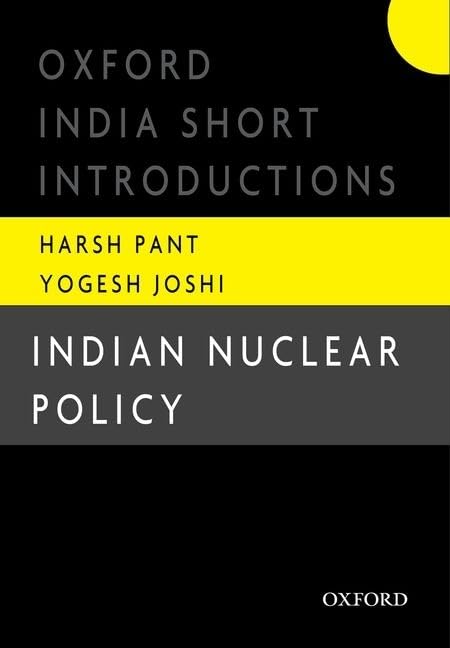
The book demonstrates how India went from being an ambivalent state and advocating against the global nuclear order to carving out a seat on the international stage for itself as a major nuclear power.
The “Indian Nuclear Policy” authored by Harsh V. Pant and Yogesh Joshi, published by Oxford University Press India [OUP India], provides a very brief and concise account of the evolution of the Indian Nuclear Policy from the period of India’s first Prime Minister, Jawaharlal Nehru, to the present. The book demonstrates how India went from being an ambivalent state and advocating against the global nuclear order to carving out a seat on the international stage for itself as a major nuclear power. India has travelled a long distance from being a nuclear pariah to a de facto member of the nuclear hub (Harsh V. Pant, 2018). India’s journey towards becoming a nuclear weapons power and simultaneously rising in the global order has been carefully illustrated through five chapters in this book. The course of the book provides a trajectory of India’s nuclear policy from the early days since gaining independence in the year 1947 to the present (Harsh V. Pant, 2018). The book elucidates not only India’s nuclear policy choices but also their impacts and consequences.
Harsh V. Pant is an established writer, scholar and professor of International Relations at King’s College London. Yogesh Joshi, apart from having co-authored two other books, has a PhD in international politics from Jawaharlal Nehru University and specialises in Indian foreign policy and security policy. The experience and expertise of both the above-mentioned authors in international relations and politics are reflected throughout the book. The authors provide a comprehensive understanding of India’s nuclear policy and security, beginning from the foundational blocks of atomic energy laid by Prime Minister Nehru post India’s Independence to the present, showing an evolution in India’s national and security interests beginning from 1947, and transitions that have occurred within India’s domestic affairs and politics.
Disarmament was an imperative aspect of foreign policy under Nehru, but India’s nuclear option provided India with the needed deterrence and strategic autonomy.
The science of Atomic Energy was associated with prestige. In the post-Hiroshima period, nuclear weapons increasingly became the benchmark for states to attain great power status (Harsh V. Pant, 2018). In pursuit of strengthening India’s national interests and security, Nehru decided to invest in atomic energy research, as he believed that the way forward towards modernity and becoming a global power was through investing in the realms of science and technology. Gandhi, however, critiqued modernity as it gave birth to colonialism, but Nehru argued that India was colonised due to the lack of science and technology.
As the authors argue, India displayed great ambivalence towards developing nuclear power as, on one hand, India wanted to develop explosive nuclear capability and, on the other hand, maintained a moral and political commitment towards peaceful uses of nuclear energy and vouched vehemently for nuclear disarmament. In my perspective, this very ambivalent nature of India concerning its nuclear policy also gave room for the Republic of Marshall Islands to bring up a case against India in the International Court of Justice [ICJ] in 2014, because India is in breach of its obligations of nuclear non-proliferation and disarmament whilst negotiating and advocating for the same on various international forums. However, the case was not taken up by the ICJ as there was no direct dispute between the two Republics.
‘Indian Nuclear Policy’ is a great handbook that provides condensed yet all-inclusive information to anyone who wishes to understand India’s Nuclear Policy.
India developed nuclear energy and subsequently nuclear weapons, although it was vociferous about nonproliferation and disarmament due to the rising threat of its nuclear weapons and technology-equipped neighbours- China and Pakistan. India, however, did not have a direct nuclear threat till China tested in 1964. Although the United States did put economic sanctions on India in protest against India becoming a nuclear power, the United States soon accepted India’s newfound status to counter China in the region. This also led to the betterment of the India-US relationship and foreign policy. Disarmament was an imperative aspect of foreign policy under Nehru, but India’s nuclear option provided India with the needed deterrence and strategic autonomy. If Nehru was the Political force behind India’s atomic energy, Homi Bhabha was his comrade-in-arms (Deshmukh, 2003).
The book very neatly outlines how Homi Bhabha significantly contributed towards the development of different nuances of India’s atomic research and nuclear program. Nehru and Bhabha also established the Atomic Energy Commission (AEC), which became one of India’s most autonomous bureaucratic institutions then. Homi Bhabha also went on to provide the ‘Three-stage atomic energy program’, a distinctive nuclear pathway for India. The authors draw upon how nuclear science would not only serve for external purposes of defence but also for the internal motive for development. Nuclear technology and the quest to become a nuclear-weapon state further flourished under India’s subsequent Prime Ministers. The timeline of India becoming a nuclear weapons power has been methodically aligned in the book with the different Prime Ministers who came to power in the country. But India’s nuclear policy has remained constant throughout different regimes of power: from the ‘No First Use’ policy to the assured strong retaliation policy.
India’s nuclear policy has remained constant throughout different regimes of power: from the ‘No First Use’ policy to the assured strong retaliation policy.
India has always aimed to have nuclear weapons and a strong nuclear policy to counter and balance the nuclear challenge that came into existence in South Asia, with China and Pakistan possessing nuclear weapons. Due to its geographical location, India is highly vulnerable to a two-front nuclear war with Pakistan on the west and China on the east. China’s revanchist activities on the eastern borders of India also pose a great threat to the country’s national security and sovereignty. India thus justifies its possession of nuclear weapons to its neighbouring nuclear-armed states of Pakistan and China. During the Kargil war, India exercised substantial restraint towards ensuring that the war didn’t expand into a nuclear conflict. India’s restraint earned it recognition of being a responsible nuclear power (Harsh V. Pant, 2018).
Many factors have played a role in shaping and sculpting India’s nuclear policy, mainly status, security, domestic politics and the role of individuals, and the book perfectly strikes a balance in exploring all these eclectic elements. An idea of the basic physics involved in the creation of nuclear weapons by India, to the different delivery vehicles and missiles utilised by the state that are needed to carry warheads, is also plainly explained by the authors, making it easy for readers to comprehend India’s nuclear policy comprehensively.
The authors also mention India developing the Multiple Independently Targetable Re-Entry Vehicle [MIRV] technology, which allows missiles to carry multiple nuclear warheads. This technology was recently successfully tested by India in March 2024, on the AGNI-V missile equipped with this very technology. The book thus not only provided a historical background of India’s developments in the nuclear domain, but also provided up-to-date insights into the developments India was making. “Indian Nuclear Policy” is thus a great handbook that provides condensed yet all-inclusive information to anyone who wishes to understand India’s Nuclear Policy.
Book Title: Indian Nuclear Policy
Authors: Harsh V. Pant, Yogesh Joshi
Publishers: Oxford University Press India (2018)
Pages: 208
Price: ₹328 (Paperback)
SW Ratings: ****1/2
Vibha Hareesh has a Bachelor’s Degree in International Relations from Jindal Global University. She has a strong interest in geopolitics, international relations, and security studies. Views expressed are the author’s own.
